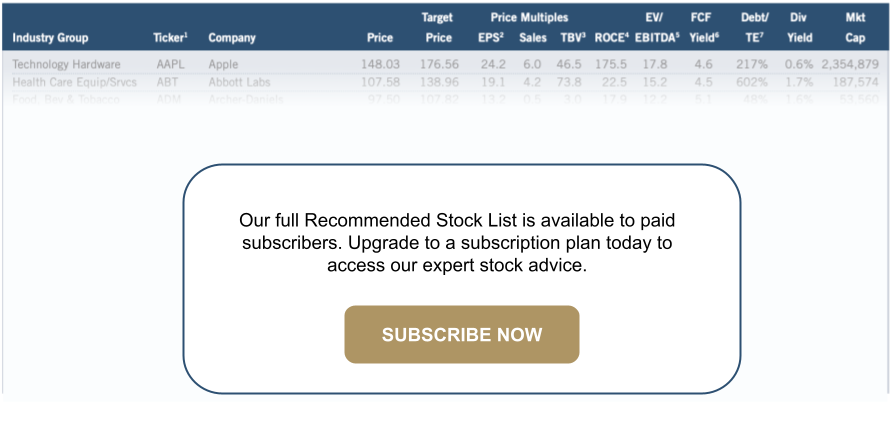Preview of January 2022 Newsletter
Editor’s Note
“I am a big cockeyed optimist. I try to accentuate the positive as opposed to the negative.” — Betty White
Incredibly, 2021 began with a Democratic sweep of the two run-off elections for the Georgia Senate seats and a Mob Storms Capitol headline in giant type in the January 7 edition of The Wall Street Journal. And the year ended with the Federal Reserve tapering its bond buying program and suggesting that there may be two or three hikes in the Federal Funds rate in 2022, while COVID-19 cases hit records around the world, with Europe imposing new lockdowns over the Holidays and the U.S. seeing thousands of flights cancelled.
Yet, even with all the supposedly equity-unfriendly news, the major market averages turned in stellar performance. The Dow Jones Industrial Average was the laggard of the large-cap indexes in 2021, but it returned 20.95%, compared to 25.66% for the broad-based Russell 3000 and 28.71% for the S&P 500. Interestingly, the Russell 3000 Value vs. Growth race was a virtual dead heat, with the former advancing 25.37% and the latter gaining 25.85%. And, showing that it is a market of stocks and not a stock market, the small-cap Russell 2000 increased 14.82%, but its Value component trounced its Growth by a score of 28.27% to 2.83%.
Obviously, it was a tremendous year for U.S. equities, while the purportedly safer fixed income benchmarks ended in the red. The Bloomberg Barclays U.S. Aggregate Bond index had a negative total return of 1.54%, with the Bloomberg Barclays Global Aggregate Bond index skidding 4.71%. Certainly, we understand that not everyone can tolerate the ups and downs of stocks so bonds have their place, but we like what our founder Al Frank wrote two decades ago when critiquing Warren Buffett’s comments at the 2001 Berkshire Hathaway Annual Meeting: I love his reaffirming that Modern Portfolio Theory’s concept of risk as quantified by beta (a measurement of volatility) is wrong [my word]. Arguably the most successful investor in the world, Buffett said, “If someone starts talking to you about beta, zip up your pocketbook…There are two kinds of risk: The risk that you could get a better return on your money elsewhere (opportunity cost) and the risk of permanent capital impairment (financial health).”
And therein lies the foundation of our continued enthusiasm for stocks. The low interest rate environment makes it difficult to get a better return elsewhere, while higher inflation and a less accommodative Federal Reserve amp the possibility that all those dollars in fixed income ETFs will suffer permanent impairment of capital.
To be sure, bonds and cash (there is $4.7 trillion currently hibernating in money market funds, with the certainty in the near-term of suffering a substantial loss of purchasing power) will always be part of most asset allocation mixes. But for those who can stomach the inevitable short-term equity market gyrations (history shows that on average 5% setbacks happen three times per year, 10% corrections occur every 11 months and 20% Bear Markets take place every 3.5 years), we think the long-term rewards from stocks, especially the less expensive names that we have long championed, remain very compelling.
Of course, many have found out the hard way that the secret to success in stocks is not to get scared out of them, but Value has had an average annualized return of 13.3% per annum since 1927. What’s more, in addition to the valuation gap between Value and Growth being as wide today as it was at the peak of the Tech Bubble, our studies of the historical evidence suggests that higher inflation, rising interest rates and increased tax rates have previously coincided with superior performance for stocks that trade for lower valuation metrics than their pricier peers.
We expect the sledding to be tougher this year than last and we know the virus is far from conquered, supply chain woes continue to be a headwind and disconcerting geopolitical events are a constant worry, so as the Oracle of Omaha proclaims, “We don’t have to be smarter than the rest. We have to be more disciplined than the rest.”
Recommended Stock List
In this space, we list all of the stocks we own across our multi-cap-value managed account strategies and in our four newsletter portfolios. See the last page for pertinent information on our flagship TPS strategy, which has been in existence since the launch of The Prudent Speculator in March 1977.
Readers are likely aware that TPS has long been monitored by The Hulbert Financial Digest (“Hulbert”). As industry watchdog Mark Hulbert states, “Hulbert was founded in 1980 with the goal of tracking investment advisory newsletters. Ever since it has been the premiere source of objective and independent performance ratings for the industry.” For info on the newsletters tracked by Hulbert, visit: http://hulbertratings.com/since-inception/
Keeping in mind that all stocks are rated as “Buys” until such time as we issue an official Sales Alert, we believe that all of the companies in the tables on these pages trade for significant discounts to our determination of longterm fair value and/or offer favorable risk/reward profiles. Note that, while we always seek substantial capital gains, we require lower appreciation potential for stocks that we deem to have more stable earnings streams, more diversified businesses and stronger balance sheets. The natural corollary is that riskier companies must offer far greater upside to warrant a recommendation. Further, as total return is how performance is ultimately judged, we explicitly factor dividend payments into our analytical work.
While we always like to state that we like all of our children equally, meaning that we would be fine in purchasing any of the 100+ stocks, we remind subscribers that we very much advocate broad portfolio diversification with TPS Portfolio holding more than eighty of these companies. Of course, we respect that some folks may prefer a more concentrated portfolio, however our minimum comfort level in terms of number of overall holdings in a broadly diversified portfolio is at least thirty!
TPS rankings and performance are derived from hypothetical transactions “entered” by Hulbert based on recommendations provided within TPS, and according to Hulbert’s own procedures, irrespective of specific prices shown within TPS, where applicable. Such performance does not reflect the actual experience of any TPS subscriber. Hulbert applies a hypothetical commission to all “transactions” based on an average rate that is charged by the largest discount brokers in the U.S., and which rate is solely determined by Hulbert. Hulbert’s performance calculations do not incorporate the effects of taxes, fees, or other expenses. TPS pays an annual fee to be monitored and ranked by Hulbert. With respect to “since inception” performance, Hulbert has compared TPS to 19 other newsletters across 62 strategies (as of the date of this publication). Past performance is not an indication of future results. For additional information about Hulbert’s methodology, visit: http://hulbertratings.com/methodology/.
Portfolio Builder
Each month in this column, we highlight 10 stocks with which readers might populate their portfolios: Air Prods & Chemicals (APD), Leggette & Platt (LEG), Exxon Mobil (XOM) and seven others.





